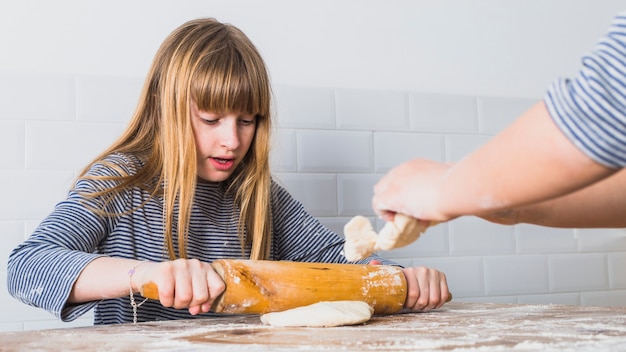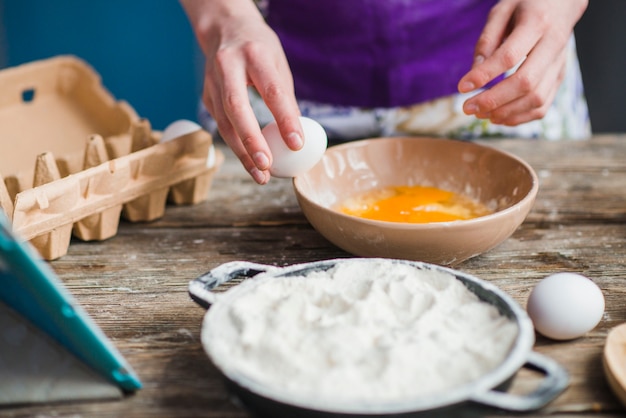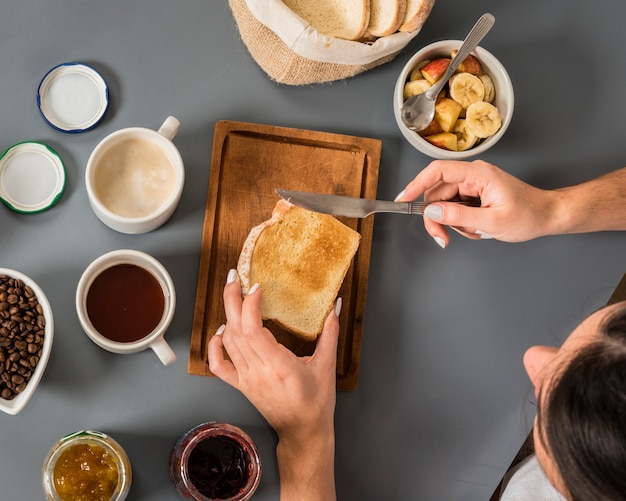The Magic of the Ingredients

The Cornmeal: The Heart and Soul
This is the star of the show, folks. Forget the coarse stuff; we're all about fine cornmeal. Think about it, would you rather bite into a smooth, creamy custard or a grainy, lumpy mess? Fine cornmeal is your ticket to that delicate, melt-in-your-mouth crumb we all crave. Over the years, I've tried countless cornmeals, but my personal favourite? Stone-ground. It brings a depth of flavour and a bit more texture that just sings to me. But, if you're new to the game, don't stress! Fine cornmeal is the key, no matter the source.
The Flour: A Touch of Lightness
Now, here's where things get interesting. Some folks swear by plain flour for a lighter texture, but I'm a big fan of adding a bit of self-raising flour. It's that perfect balance, you see. A little lift, a little fluffiness, a satisfying bite. Think of it as a secret ingredient, a touch of magic that elevates the entire experience.
The Sugar: A Hint of Sunshine
Now, don't shy away from a little sweetness. Just a touch of sugar is all it takes to awaken the flavours in your cornbread, like adding a sprinkle of sunshine to a cloudy day. It's subtle, it's gentle, it's just enough to make your cornbread sing.
The Milk: The Key to Moisture
Milk is the secret weapon to keeping your cornbread moist and tender. My personal preference? Buttermilk. It adds a delightful tang that just can't be beat. But full-fat milk is a fantastic alternative. The key is to avoid watery milk. You want a batter that's nice and thick, not runny.
The Eggs: The Binding Force
Eggs are the glue that holds everything together. They add richness, structure, and a touch of decadence. Don't be afraid to use whole eggs, even if you're watching your cholesterol. A little richness goes a long way, and trust me, it's worth it.
The Butter: The Flavor Amplifier
Ah, butter. The ingredient that makes cornbread truly sing. Unsalted butter is the way to go here, giving you complete control over the flavour. It melts beautifully, creates a tender crumb, and brings that subtle, irresistible richness that's the hallmark of great cornbread.
The Baking Powder: The Rising Star
Baking powder is your secret weapon, the magic ingredient that makes your cornbread rise beautifully. Make sure it's fresh! Otherwise, you'll end up with a flat, deflated cornbread, and nobody wants that. Speaking of rising, don't overload the pan. It's tempting, I know, but give your cornbread some space to breathe. It'll thank you for it.
The Salt: The Balancing Act
A pinch of salt is all it takes to enhance the sweetness, balance the flavours, and bring out the best in your cornbread. Don't overdo it, though. Just a little goes a long way.
(Part 2)

The Art of Mixing

The Right Way to Mix: A Gentle Approach
I always start by whisking together the dry ingredients. This ensures everything is perfectly blended and evenly distributed. Once those are combined, I add the wet ingredients and mix until just combined. Remember, we're aiming for a few lumps here. That's what gives cornbread its unique texture.
Avoiding the Overmixing Trap: The Key to Tenderness
Overmixing is a common cornbread crime, but it's easy to avoid. The trick is to stop mixing as soon as the ingredients are just combined. Any more mixing, and you'll develop the gluten in the flour, making your cornbread tough and chewy. No one wants a tough, chewy cornbread, right?
The Importance of Patience: Letting the Flavours Mingle
Patience is a virtue, my friends. Let the batter sit for a few minutes. It gives the baking powder a chance to activate, allowing those magical little bubbles to form. It also gives the flavours time to mingle and really develop.
(Part 3)
The Baking Process: Oven Time!
Now, we're getting down to the heart of the matter, the baking process. The oven is your best friend when it comes to cornbread, and it's all about finding that perfect sweet spot.Preheating the Oven: Setting the Stage
Always, always preheat your oven to 400 degrees Fahrenheit (200 degrees Celsius). It ensures your cornbread bakes evenly and develops that beautiful golden crust.
The Right Pan: The Perfect Vessel
I'm a big fan of using a cast iron skillet for cornbread. It distributes heat beautifully, creating that lovely crispy edge. But if you don't have a cast iron skillet, a regular 9-inch square baking pan works just fine. Just make sure to grease it well with butter.
Baking Time: The Golden Rule
Baking time can vary depending on your oven and the size of your pan, but it's usually around 20-25 minutes. You'll know your cornbread is ready when the top is a gorgeous golden brown and a toothpick inserted into the center comes out clean.
Resting Time: Cooling Down for Perfection
Don't rush into slicing your cornbread right after it comes out of the oven. Let it rest for about 10 minutes. This allows it to cool and firm up, making it easier to slice without crumbling.
(Part 4)
The Art of Serving: The Final Flourish
Now, it's time to showcase your masterpiece! Serving your perfect cornbread is an art in itself.Adding a Touch of Sweetness: Classic Pairings
A dollop of butter or a drizzle of honey is a classic cornbread pairing. It brings out the sweetness and adds a touch of decadence that's truly irresistible.
The Savoury Side: Cornbread's Versatility
Don't underestimate the power of cornbread on the savoury side. It pairs beautifully with chili, hearty stews, and warming soups. You can even crumble it up and use it as a topping for your favourite casserole.
The Fun Factor: Get Creative!
Don't be afraid to experiment with your cornbread! Add chopped pecans, blueberries, or even shredded cheese. It's all about finding what you love best, creating your own unique signature cornbread.
(Part 5)
Tips and Tricks: Mastering the Craft
Now, let's delve into some insider tips and tricks that will help you take your cornbread game to the next level.The Secrets of a Perfect Crumb: The Right Consistency
To achieve that perfect, light crumb, I always use a little less milk than most recipes call for. It prevents the cornbread from becoming dense and chewy, ensuring a light and airy texture.
Avoiding Dry Cornbread: Adding Moisture
Worried about dry cornbread? Add a tablespoon or two of sour cream to your batter. It adds moisture, a touch of tang, and a silky texture that's hard to resist.
The Sweet Spot for Sweetness: Finding Your Balance
I like my cornbread with a hint of sweetness, so I add a bit of sugar. But if you prefer your cornbread savoury, simply omit the sugar or add a pinch of salt for a more robust flavour.
The Power of Herbs: Infusing Flavor
Adding fresh herbs like chives or thyme can give your cornbread a unique and flavourful twist. Experiment with different herbs to find your favourite combinations.
The Beauty of Experimentation: Discover Your Own Style
Remember, this is your cornbread journey! Experiment, have fun, and don't be afraid to try new things. You might just discover your new favourite cornbread recipe!
(Part 6)
Common Mistakes and How to Avoid Them: Learning from Experience
Let's be honest, we all make mistakes in the kitchen. But with a little knowledge, we can avoid some of the most common cornbread pitfalls.Overmixing: The Enemy of Tenderness
Overmixing is a major cornbread no-no. It leads to a tough, chewy texture. To avoid this, mix your batter until just combined and stop. Remember, a few lumps are a good thing.
Using Old Baking Powder: The Importance of Freshness
Old baking powder doesn't work as effectively, resulting in a flat and deflated cornbread. Always check the date on your baking powder and replace it if it's expired.
Not Preheating Your Oven: A Crucial Step
Preheating your oven ensures that your cornbread bakes evenly. Always preheat your oven to the recommended temperature before putting your cornbread in the oven.
Cutting into Cornbread Too Soon: Patience is Key
Give your cornbread time to rest after baking. It allows it to cool and firm up, making it easier to slice without crumbling.
Using the Wrong Type of Cornmeal: Fine is Key
Use fine cornmeal, not the coarse stuff. It's essential for creating that delicate crumb we all love.
(Part 7)
Variations on the Classic Recipe: Expanding Your Horizons
Now, let's explore some variations on the classic cornbread recipe. These are some of my personal favourites, and I'm sure you'll find something you love.cheddar cornbread: A Cheesy Delight
For a cheesy twist, simply add a cup of shredded cheddar cheese to your batter. It's a classic combination that's always a crowd-pleaser.
Jalape??o Cornbread: A Spicy Kick
Add a little kick to your cornbread with some chopped jalape??os. It's a delicious and spicy twist on the classic.
blueberry cornbread: A Sweet and Fruity Treat
For a sweet and fruity treat, add a cup of fresh or frozen blueberries to your batter. It's a perfect summery dessert.
honey cornbread: A Deeper Sweetness
For a more intense sweetness, replace some of the sugar with honey. It adds a lovely depth of flavour and a touch of decadence.
Savoury Cornbread: A Hearty Choice
For a savoury take on cornbread, omit the sugar and add a pinch of salt. It's perfect for pairing with soups and stews.
(Part 8)
Storage and Leftovers: Making the Most of Your Bake
Now, let's talk about how to store your cornbread and make the most of any leftovers.Storing Your Cornbread: Keeping It Fresh
To keep your cornbread fresh, wrap it tightly in plastic wrap or aluminium foil. You can store it at room temperature for up to 2 days or in the fridge for up to 3 days.
Reheating Your Cornbread: Restoring the Warmth
To reheat your cornbread, simply wrap it in foil and place it in a preheated oven at 350 degrees fahrenheit (175 degrees Celsius) for about 10 minutes.
Using Leftovers: Getting Creative
Don't throw away those leftover cornbread crumbs! You can use them to make bread pudding, cornbread croutons, or even a cornbread topping for your favourite casserole.
(Part 9)
FAQs: Answering Your Questions
Q: What's the best type of cornmeal to use for cornbread?
A: I prefer stone-ground fine cornmeal for its rich flavour and slightly coarser texture. But, if you're just starting out, any fine cornmeal will work just fine.
Q: Can I use regular milk instead of buttermilk?
A: Absolutely! If you don't have buttermilk, you can use regular milk. Just add a tablespoon of white vinegar or lemon juice to the milk and let it sit for 5 minutes to create a similar tang.
Q: How do I know if my cornbread is done?
A: Insert a toothpick into the center of your cornbread. If it comes out clean, it's done. If it's still moist, bake for a few more minutes.
Q: Why is my cornbread dry?
A: This usually happens when the cornbread is overbaked. To avoid this, keep a close eye on your cornbread and remove it from the oven as soon as it's golden brown and a toothpick comes out clean.
Q: How can I make my cornbread extra moist?
A: Add a tablespoon or two of sour cream to your batter. It will add moisture and a touch of tang.
There you have it, my friends! The ultimate guide to making perfect cornbread. Now go forth and bake! I'm confident that you'll be whipping up delicious cornbread in no time. And don't forget to have fun! That's what baking is all about. Happy baking!
Everyone is watching

Prime Rib Roast Cooking Time Chart: Per Pound Guide
Cooking TipsPrime rib roast. Just the name conjures images of lavish dinners, crackling fires, and hearty laughter. It’s ...

How Long to Bake Potatoes in the Oven (Perfect Every Time)
Cooking TipsBaked potatoes are a staple in my kitchen. They're incredibly versatile, delicious, and surprisingly easy to m...

Perfect Rice Every Time: The Ultimate Guide to Cooking Rice
Cooking TipsAs a self-proclaimed foodie, I've always been a bit obsessed with rice. It's the foundation of countless cuisi...

The Ultimate Guide to Cooking Asparagus: Tips, Techniques, and Recipes
Cooking TipsAsparagus. The mere mention of this spring delicacy conjures up images of vibrant green spears, crisp and burs...

Ultimate Guide to Cooking the Perfect Thanksgiving Turkey
Cooking TipsThanksgiving. Just the word conjures up images of overflowing tables laden with delicious food, the scent of r...
